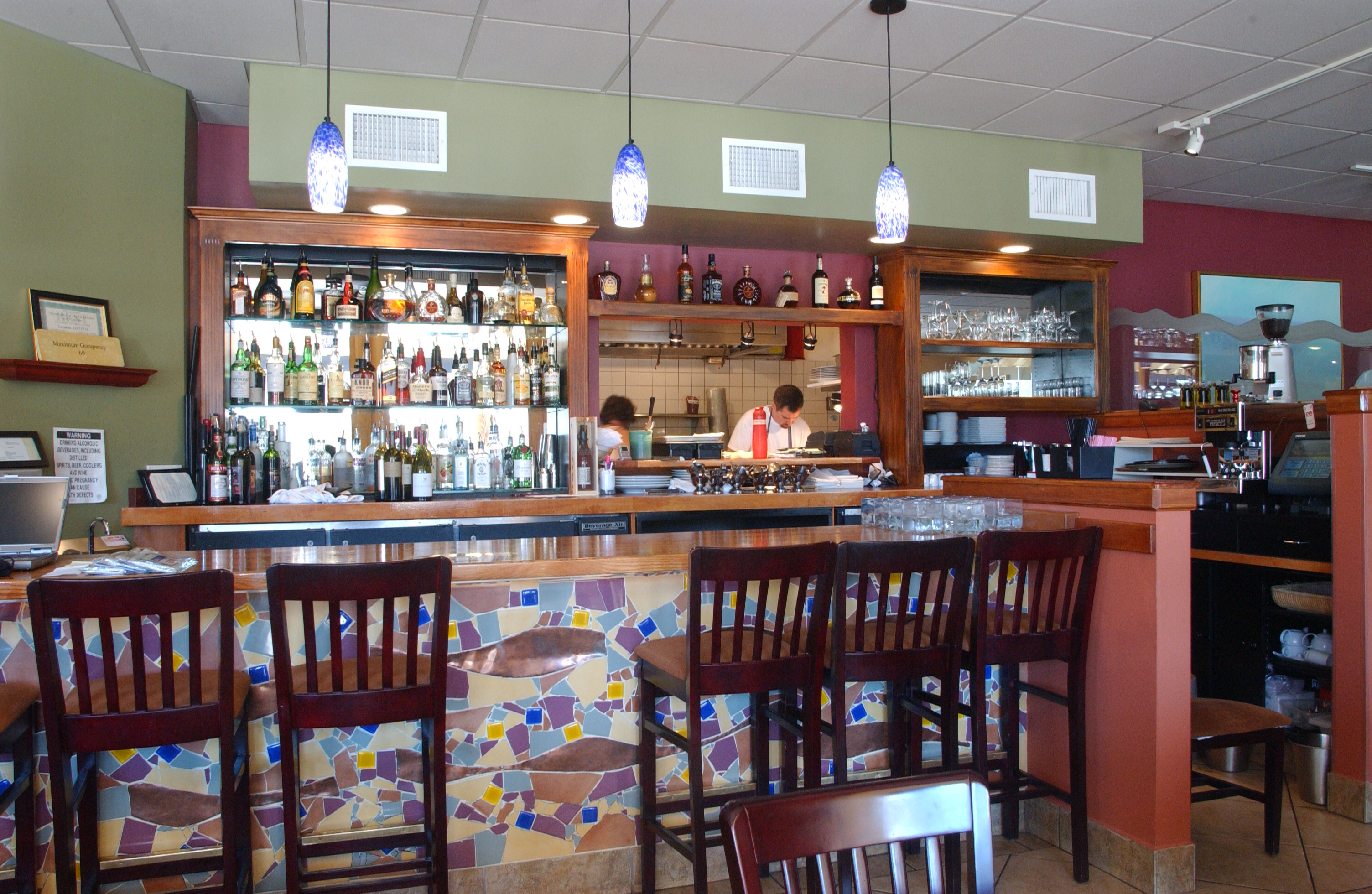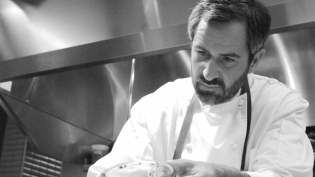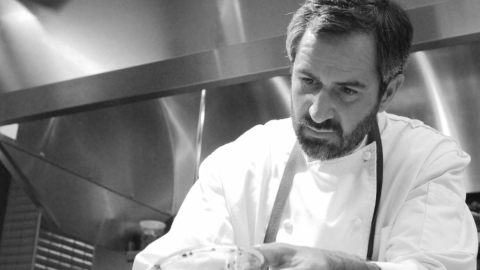The Secrets Behind the Kitchen Window at Binkley’s
Perched on a barstool in the most talked about restaurant in the Valley, I can only see a fraction of the kitchen through the tiny window behind the bar. I am certain there is more going on than meets the eye, but all I see is a tall man with a neatly trimmed goatee and Zen-like movements. Plate after plate is placed in the window before it disappears into the hands of a stealthy server. What is going on back there that I can’t see? The curiosity is killing me.
Kevin and Amy Binkley opened Binkley’s Restaurant to much fanfare in the unlikely Northern Valley cowboy outpost of Cave Creek in May, 2004. It now takes weeks to secure a reservation. The local media persistently drool over Binkley’s edible art.
Chef Kevin Binkley’s champion culinary pedigree includes serious stints at two of the country’s most renowned restaurants: Virginia’s Inn at Little Washington, and The French Laundry in Napa Valley. What would it be like to walk in his shoes for a day? I recently found out when Binkley agreed to let me shadow him for a day, from the moment he arrived, until he locked the doors at the end of the evening. Would I discover the secrets behind Phoenix’s hottest restaurant?
Just after noon on a Tuesday, Binkley leads me through the swinging doors to the kitchen. I am transported from a quiet 52-seat dining room into another world: blinding lights, clanging pots, and muted chatter from a half dozen cooks milling about cramped quarters. Binkley introduces me to his crew, who are sandwiched between a line of stoves on one side, and a slim countertop on the other.
“I hire future chefs, not cooks,” he says. “They will leave here ready to open their own places.”
1:00 p.m. Binkley found out before he arrived that two of his key suppliers would be late. We squeeze our way through the line and he answers a handful of questions from his young cooks. We pause briefly at the two foot by three foot window that peers into the dining room, the stage from which he will conduct his band of artisans in a few hours.
Binkley cleans a tray of Alfonsino, snapper-like red fish from New Zealand, which less than 48 hours ago were swimming in the ocean. After scaling the fish, Binkley methodically fillets them with a long, sharp slicing knife, his favorite.
1:45 p.m. The stovetops are blazing, covered with a half dozen pots. More fresh fish arrives at the back door. A four foot Ono in a Styrofoam container is perched on ice. Binkley points out a chunk missing near the tail of the Hawaiian white-fleshed fish. “They removed that to check the quality. I only want sushi grade,” he says.
Amy Binkley hands over a check for the Ono, and tells Binkley she’s figured out what she wants for her birthday next week. “Bacon-wrapped prunes,” she blurts. “Really?” he says, “Sold!” Triumphantly, she returns to the dining room, her domain, even though she, too, is a trained chef.
A pan of roasted chestnuts emerges from the oven and a cook with asbestos hands painstakingly peels them for tonight’s soup. Binkley finishes filleting the Alfonsino, showing me the white flecks in the flesh. “That’s fat content – it’s just buttery, and melts in your mouth,” he coos.
2:15 p.m. A cook is wedged in the teeny pantry in the back working under a spotlight. He hollows an indentation in baked fingerling potatoes, scoops the flesh into a bowl, and mashes butter, crème fraîche, and herbs into the potato remnants. He carefully pipes the filling into the hollowed fingerlings, creating miniature twice-baked potatoes with perfectly coiffed tops. Before he makes the whole batch, he bakes two to check the consistency of the filling.
2:45 p.m. Binkley turns his attention to a cook who is boiling hand-cut French fries. He says he learned the key to perfectly crunchy French fries while vacationing in London last summer. The secret is a triple cooking process. He first boils the potatoes in water, and then blanches them in 325 degree oil, before a final fry at 350 degrees when ordered.
3:00 p.m. Four cooks break away from their tasks to check in the late produce. Binkley is on the phone with his rep, complaining about the late delivery as his cooks scramble to dole out the supplies.
He tackles the Ono, slicing down one side of the backbone, taking steps as it is too long to cut in one fell swoop, even with his lengthy arm span. He turns the fish and cuts the other side and frowns. The flesh is not smooth. Bad handling he says, and instead of the 20 portions he was counting on, he only manages 13. The scraps are given to a cook to prepare for the staff meal.
3:25 p.m. More chestnuts are stripped from their roasted shells, as Binkley checks on the progress. Quietly disappointed, he instructs another cook to start a celery root soup, and makes a notation on the menu. Chestnuts are now slated as the garnish instead of the main ingredient.
4:00 p.m. The mood in the kitchen switches gears – less talking and a quickened pace. Binkley scales Barramundi, farm-raised fish with mottled gray skin glinting pink and blue that will be roasted whole. Scales fly everywhere; one lands on my shoe that I find later, a badge of honor. He shows me the bright crimson gills. “It’s fresh as can be, but it’s also a function of how they kill it. They slowly decrease the water temperature, eventually freezing the fish to death,” he says. Cruel, I ask? He nods slowly and then shrugs, as if to say it is all part of the food chain.
He stops to sweep the floor around his station. No one bats an eye, except me.
4:30 p.m. Binkley has his eye on everything and everyone, gently prodding some cooks. He chats with the pastry cook about a new dessert. She suggests bread pudding but he counters with panna cotta, with olive oil. “Maybe add a vanilla bean in addition to extra virgin olive oil,” he says. He instructs a cook to puree the celery root soup.
5:10 p.m. The cooks adjourn to the dining room to review the menu with the servers, who ask questions about the origins of the evening’s entrées. The pheasant is from Wisconsin, the pork is from White Marble Farms. Once they return to the kitchen, the cooks review prep lists, and gather all the ingredients they’ll need once the orders start rolling in. Binkley’s hands are still for the first time all day. He slides on a crisp, clean chef’s coat. It’s show time.
5:30 p.m. The first guests arrive, and Binkley chats with them through his window. The cooks are stacking piles of dishes and sauté pans near their stations. Binkley shows me three menus for the evening. “We don’t ‘86’ anything. We just print new menus and switch gears,” he says.
Only a few pots sit bubbling on the stove, a far cry from the height of thirteen I counted two hours ago. I’ve only seen a fraction of what really transpired these past five hours. I squeeze into a corner hoping to stay out of the fray.
6:00 p.m. The ticket machine spews its first order. Binkley calls out the courses by name, to no one in particular it seems, but the appropriate cook repeats the order and sets to work. Soon more orders rattle through the machine, and now four tickets hang under his window. Binkley is moving through the line, tasting everything, adjusting seasonings. He calls out for a VIP plate, a baby octopus salad, and then tells the customer at the bar “just because you’ve retired doesn’t mean you can get away with only two courses.”
6:30 p.m. The line is hopping. Binkley inspects a foie gras trio appetizer plate and gently chides the cook to “broaden her horizons, do something different,” with the balsamic reduction drizzle design. She asks if he’ll show her how he would do it. “You want me to do a plate for you,” he kids in his best mafia voice. “No,” she says, “I can handle it.” The ticket machine is spitting more orders. “One lamb, medium rare, one Ono, well done – what a shame,” he says. He calls the orders out loud, but makes the shame comment to himself, under his breath.
7:00 p.m. A few minutes of calm preside over the kitchen and everyone takes the brief respite to clean their stations. The ticket machine cranks up again. Two cooks are huddled in the back, still peeling chestnuts. A cook puts an octopus salad in the window. Binkley pulls it down, and gently whispers something in the cook’s ear. The plate is rearranged and passes inspection. He hasn’t raised his voice once today, nor thrown any fits, nor made anyone feel inferior.
7:30 p.m. The appetizer station is behind. Binkley calls up two cooks from the back, both ecstatic to leave the chestnuts behind and join the front line. More tickets are flying out of the machine; he now has five in front of him. Plates are put in front of him with rapid succession, and he deftly addresses each one, fussing with the components. He marks his tickets as each plate leaves the kitchen. At any given time, he knows which table is on which course.
7:45 p.m. The line is bump and grind; a flurry of choreographed bounces. All that’s missing is a little Lambada music. The orders are whizzing through the ticket machine. Binkley calls them out; his cooks repeat the words in monotones, toggling between constructing plates and searing proteins. The appetizer station is in the weeds again and reinforcements reappear from the back. Arms reach over bodies, grabbing squeeze bottles and plates. The sound of sizzling meat drowns out the clattering ticket machine.
8:00 p.m. Binkley leans toward the window to shoot the breeze with guests; meanwhile the kitchen is in a chaotic modern dance, a furious pace. He calls for another VIP plate, this time seared duck breast with quinoa and candied mint. He returns another octopus plate to the cook and gently says, “Remember?” The cook nods and tries again. Binkley inspects a salad with a crisp prosciutto garnish, and adds another one. “We’re cheap on the prosciutto tonight, are we?” he asks, chiding the cook. She has to fry more to make up for her boss’s generosity. He finishes assembling a half dozen other dishes and grabs more tickets, now multiplying like rabbits.
8:30 p.m. The cooks are moving at warp speed, their faces intent. Binkley checks with his expediter on the other side of the window for the pulse of the dining room. She tells him to slow down on table 22, they’re not progressing, but table 9 is ahead of schedule. The ticket machine coughs up two more orders. Binkley fillets a roasted fish, “I love roasting fish on the bone, it’s so juicy,” he says, handing me a piece that fell off the fillet. He softly tells the octopus-plate-challenged cook to re-plate a duck appetizer with a better mango design.
9:00 p.m. Only two tickets hang in front of Binkley as the machine cranks up again, and more guests arrive at the door. The cooks fill the lull in action with chestnut peeling. Binkley calls out more orders, and the line takes off again. He marks the tickets, now numbering five, keeping track of who’s on first. Tete de Moine, a semi-firm cheese from Switzerland, one of six cheeses for another VIP plate, is gathered in a ribbon by the rotating blade of a girolle cutter.
9:30 p.m. Binkley fillets another whole fish, and tells me how his cooks can read him like a book. “Sometimes I just look at them, and they know what I want.” A guest returns a medium-cooked Ono for more cooking. Binkley asks if the guest knew it was supposed to be served medium. He rolls his eyes, but returns the fish to the line for a hot oil bath, requesting fresh garnishes and sides for the doomed fish. Three tickets are active and the machine spits out another order.
10:00 p.m. The hot line begins to close down as a friend of Binkley’s, another local chef, pops in to say hi. Binkley treats him to a thrice-cooked French fry, asking the chef if he’s ever tasted a more perfect fry. “Never,” the chef says, savoring the crunch. The kitchen is slowing down. Cooks pull inventory from the refrigerators to count what’s left over. Binkley plates two last dishes, and then begins to put away his garnishes. He washes the counter and walls with a bucket of hot, soapy water. His stage gleams.
10:30 p.m. Amy Binkley stops in the kitchen for a cup of soup, pats Binkley on the arm and says, “Honest, all I want for my birthday is the bacon-wrapped prunes.” She gently squeezes his arm, and they share a tender, but fleeting moment. Binkley leaves the kitchen to circle the dining room, stopping at the handful of lingering tables. He sits at the bar to chat with his chef friend, and jots notes down on a piece of paper. The cooks are cleaning the kitchen, putting leftover inventory away and making their own notes.
10:50 p.m. Two tables are hanging on. Binkley orders a glass of zinfandel. The last guests leave and he stands to bid them goodnight. They stop and admire the framed Bon Appétit page proclaiming Binkley’s Restaurant one of the top “Hot 50: Where to Eat Now.” He tells me after the guests leave that this was a good night. He jokes that he would have preferred a little more chaos. He is still two hours away from locking the door.
11:00 p.m. His friend takes off, and Binkley turns back to his notes. He wants to order some candy-striped beets to add color to the roasted beet appetizer. He notes that the herb garden just off the kitchen side door needs watering, and he takes me into the back to check on his micro greens – radish, mustard greens, and amaranth, among others – hidden high atop a shelf in the back pantry, nurtured by grow lights. The cooks are almost finished cleaning, and he tells them to meet him in the dining room for the postmortem.
11:30 p.m. The cooks straggle to the front, chatting about who sold more food, and how disasters were averted. Some grab a beer from the bar before settling down to business. Binkley announces he has shrimp coming in from Florida later in the week. He asks if there are enough roasted beets for tomorrow. He switches gears faster than a Maserati. “Duck breast, how many do we have? We’re good on soup?” he kids. Laughter erupts as everyone took a turn peeling chestnuts throughout the day.
12:00 p.m. Each cook has his or her prep list in front of them. Binkley has a copy of the menu. The pheasant will be replaced with veal. Do they want to do “veal squared,” he asks? Yes, cheek and sweetbread. He wants to bring in Red Oak lettuce from a local farm to add color to the salad greens. “Do we still have gooseberries?” he asks. Yes. “I say we do duck confit perogies, with gooseberries.” Binkley and his band of cooks speak like they move in the kitchen, a dance done a hundred times before. At the end of an hour, they have re-written more than half of the menu for tomorrow, and an order list is put together.
12:30 p.m. The cooks begin to disperse. Binkley sits alone at the table, reviewing the newly minted menu and assembling his order list. He calls in the orders, leaving detailed messages for a handful of suppliers. He smiles at me, not showing even a hint of exhaustion. In fact, he seems eerily peaceful. The last task is to turn off the lights, set the alarm and lock the door, but not before one last stroll through the kitchen, checking equipment, and pausing a moment to reflect on another day on the books. The show’s over. At least until tomorrow.






